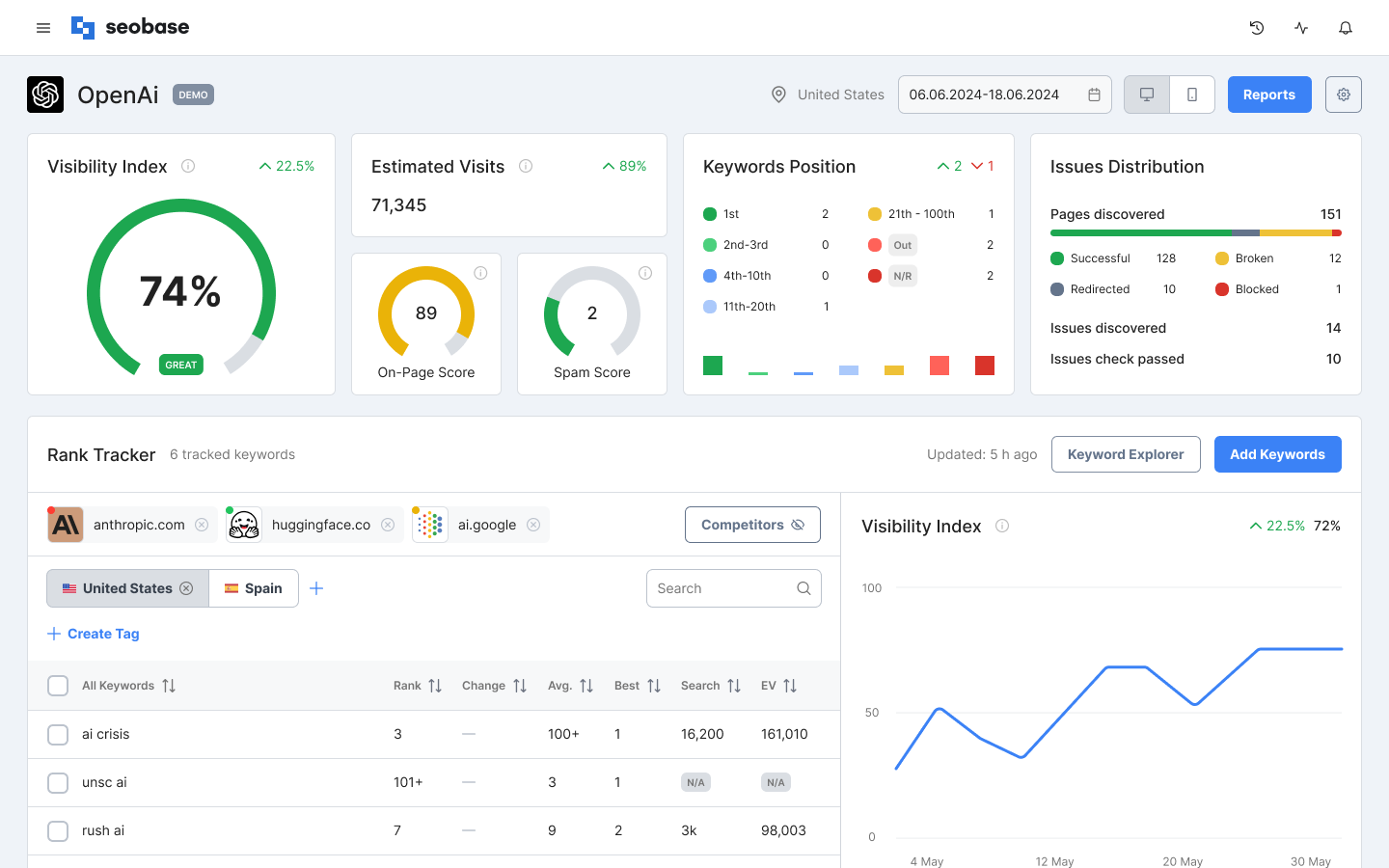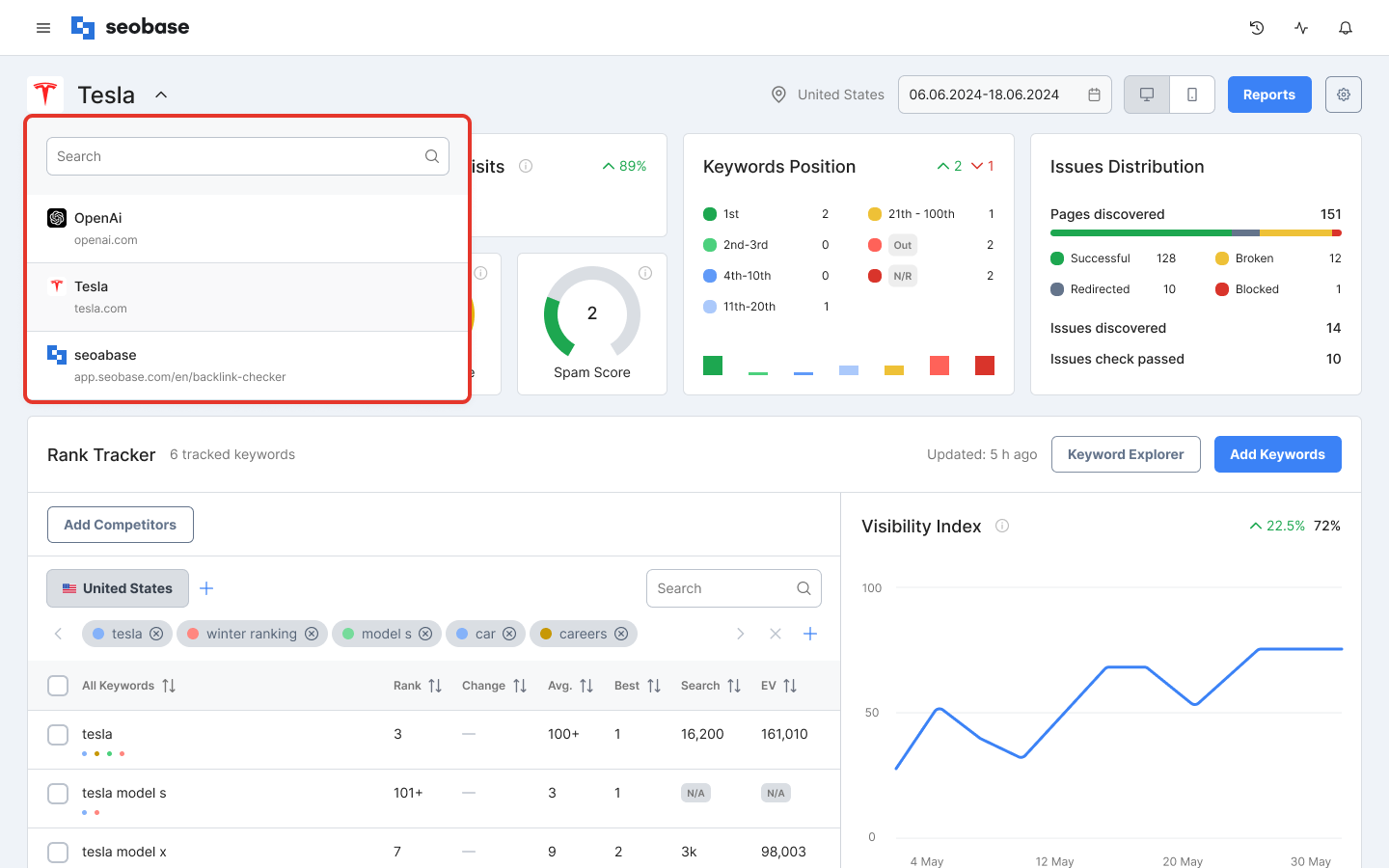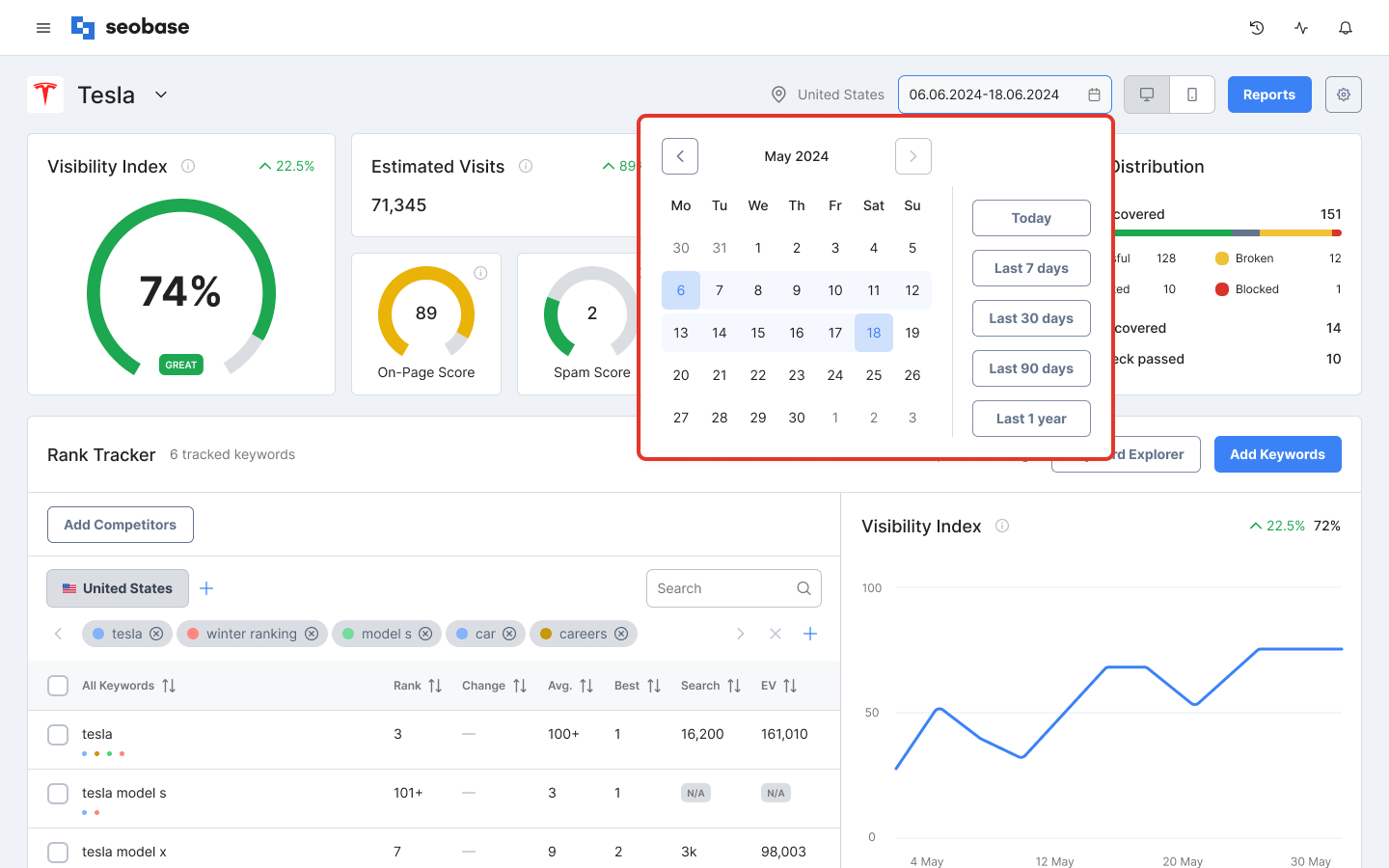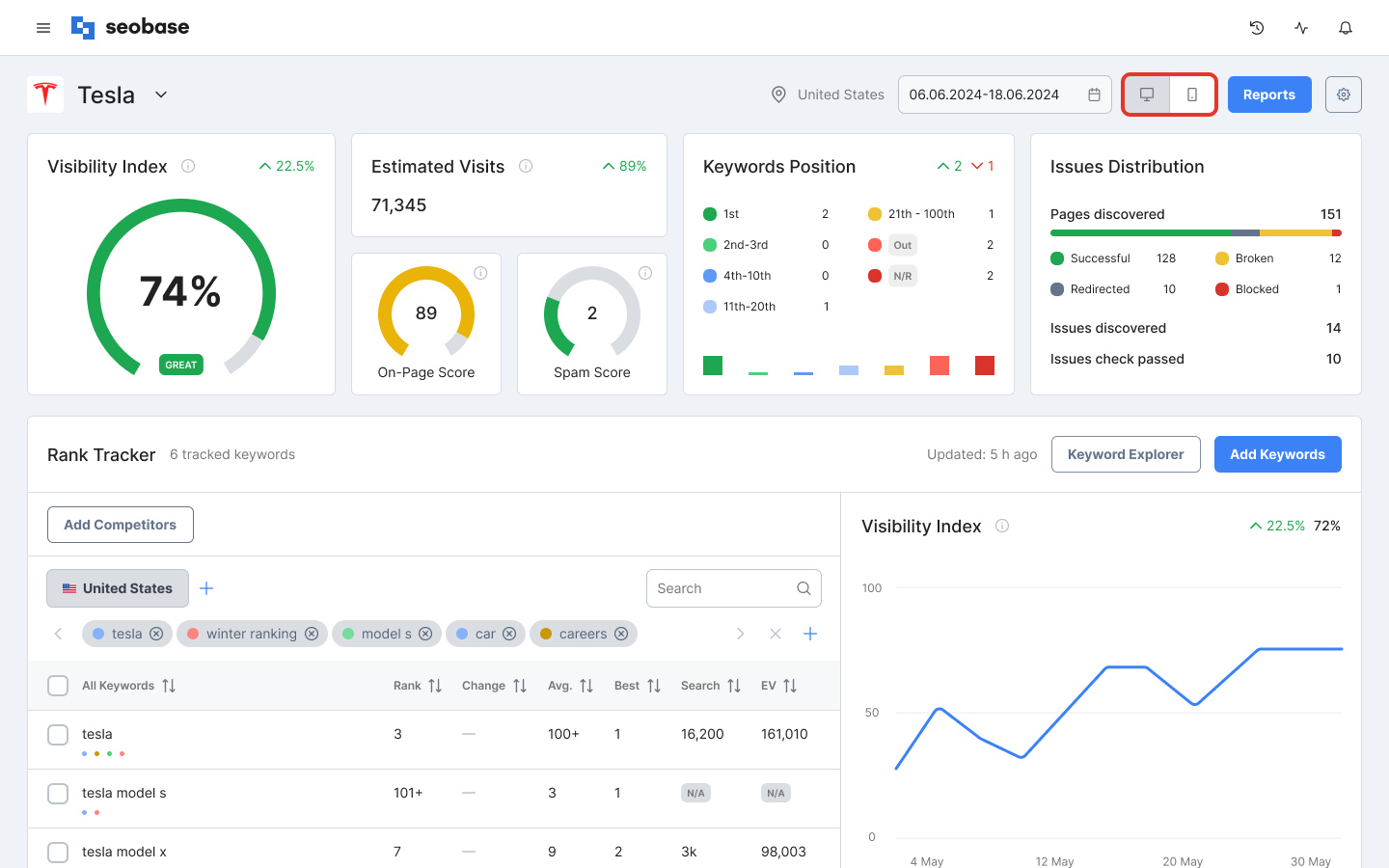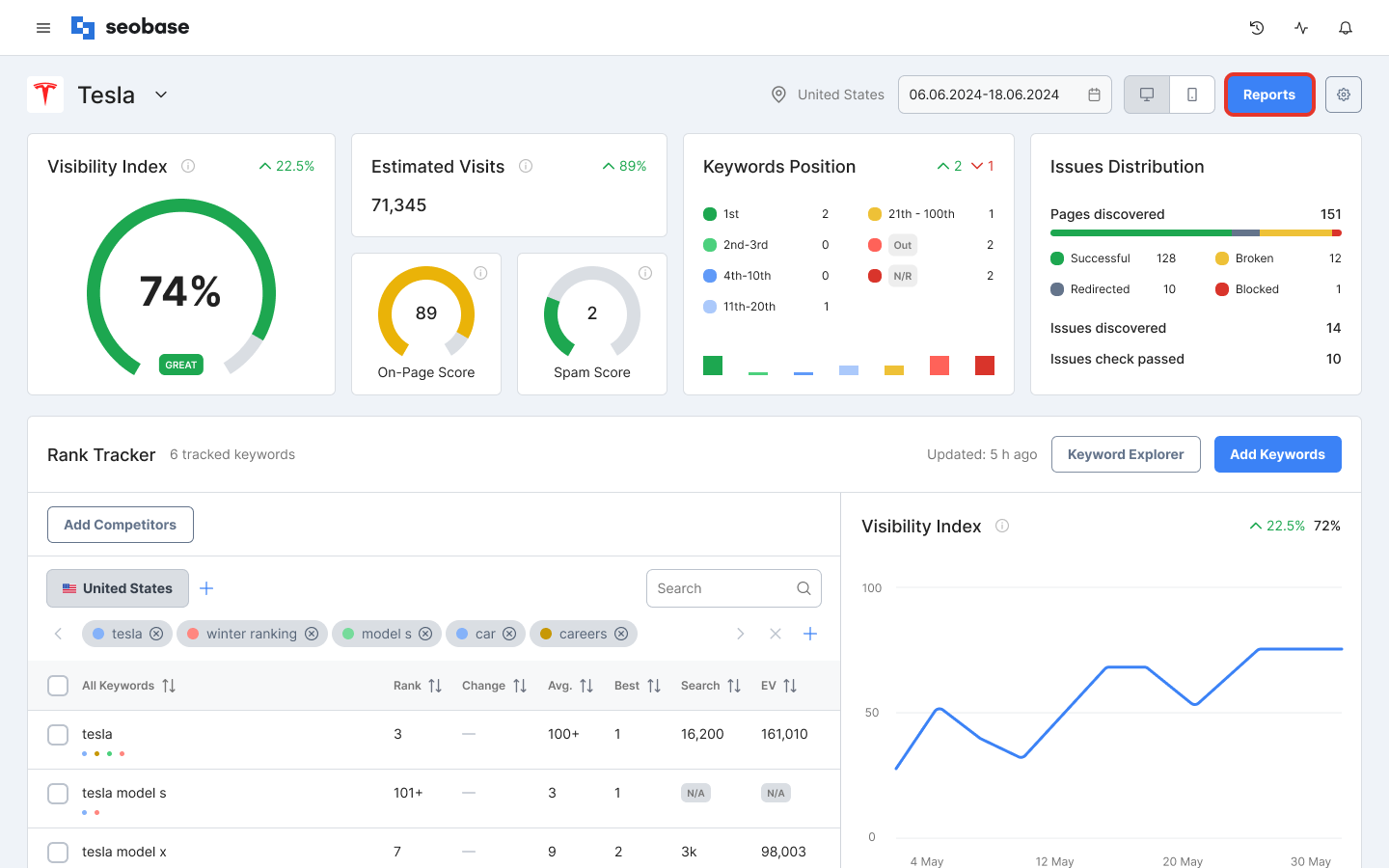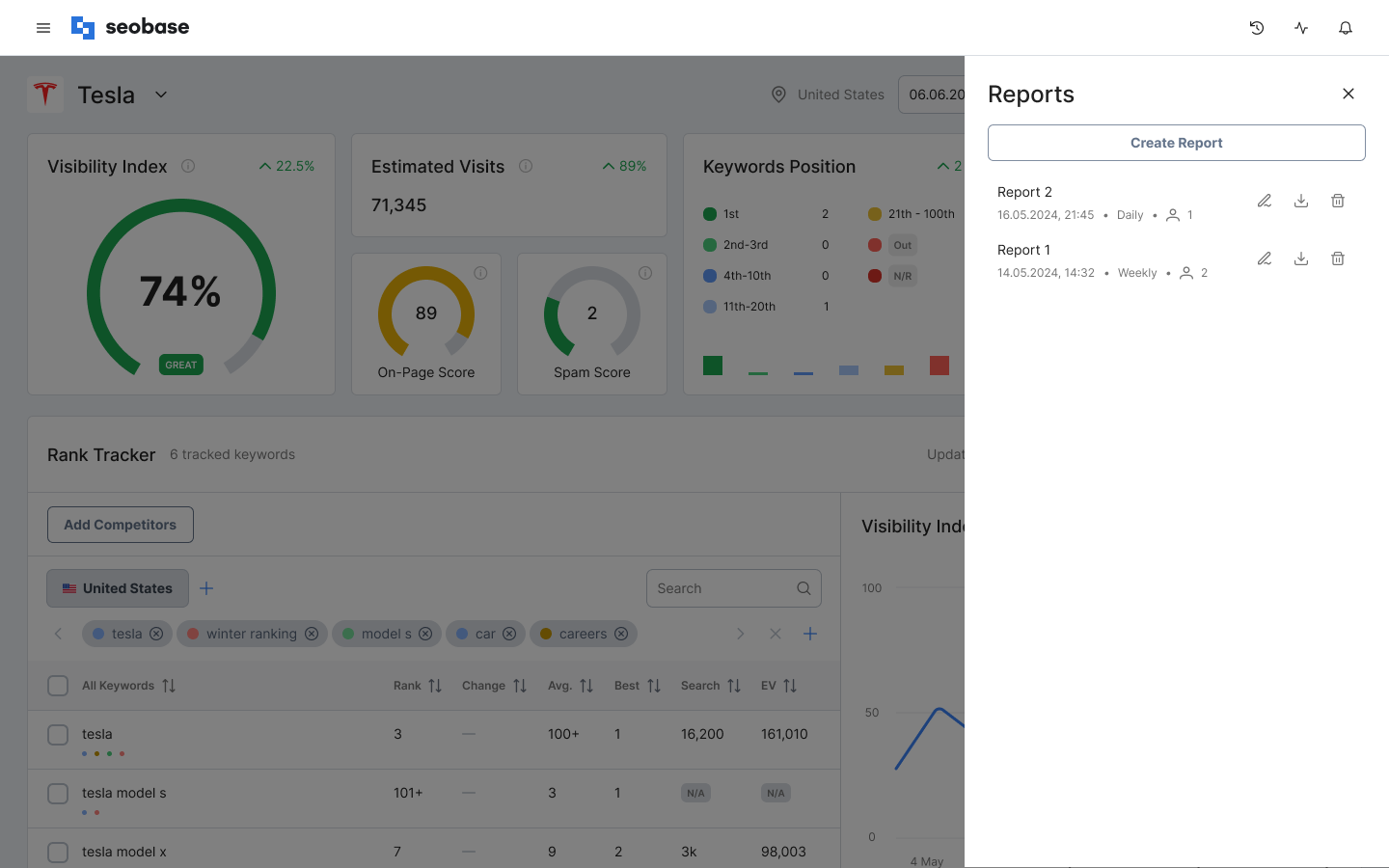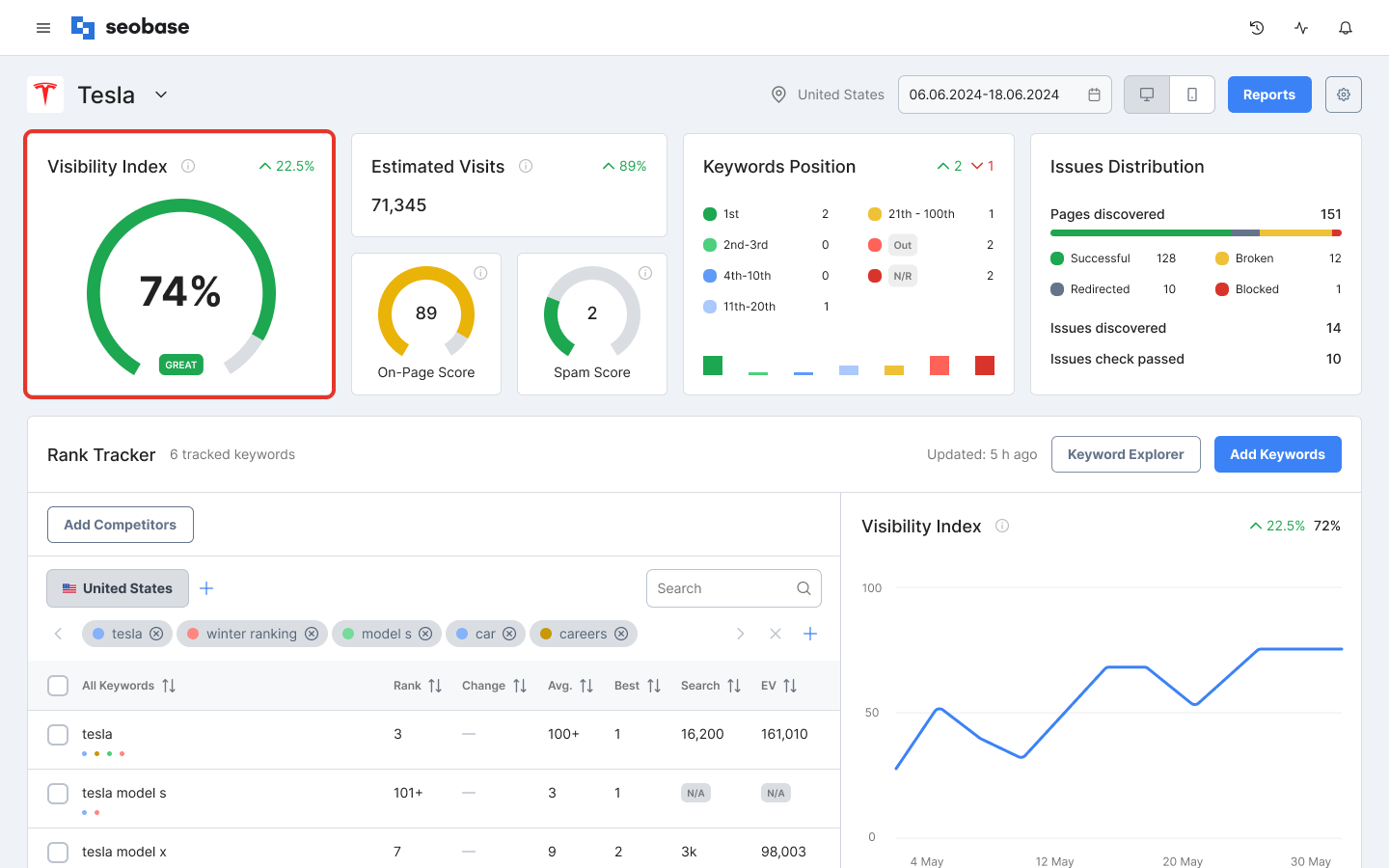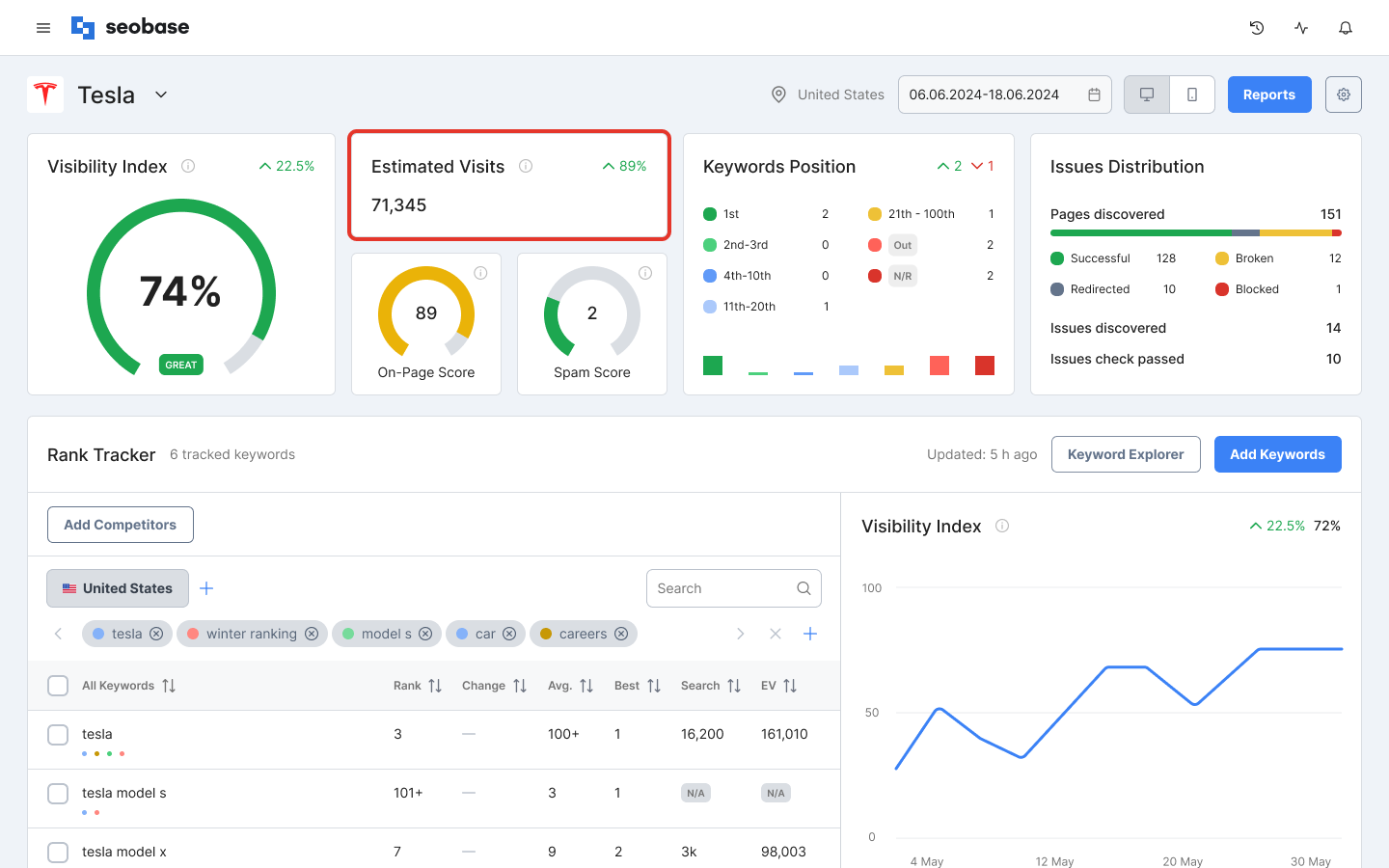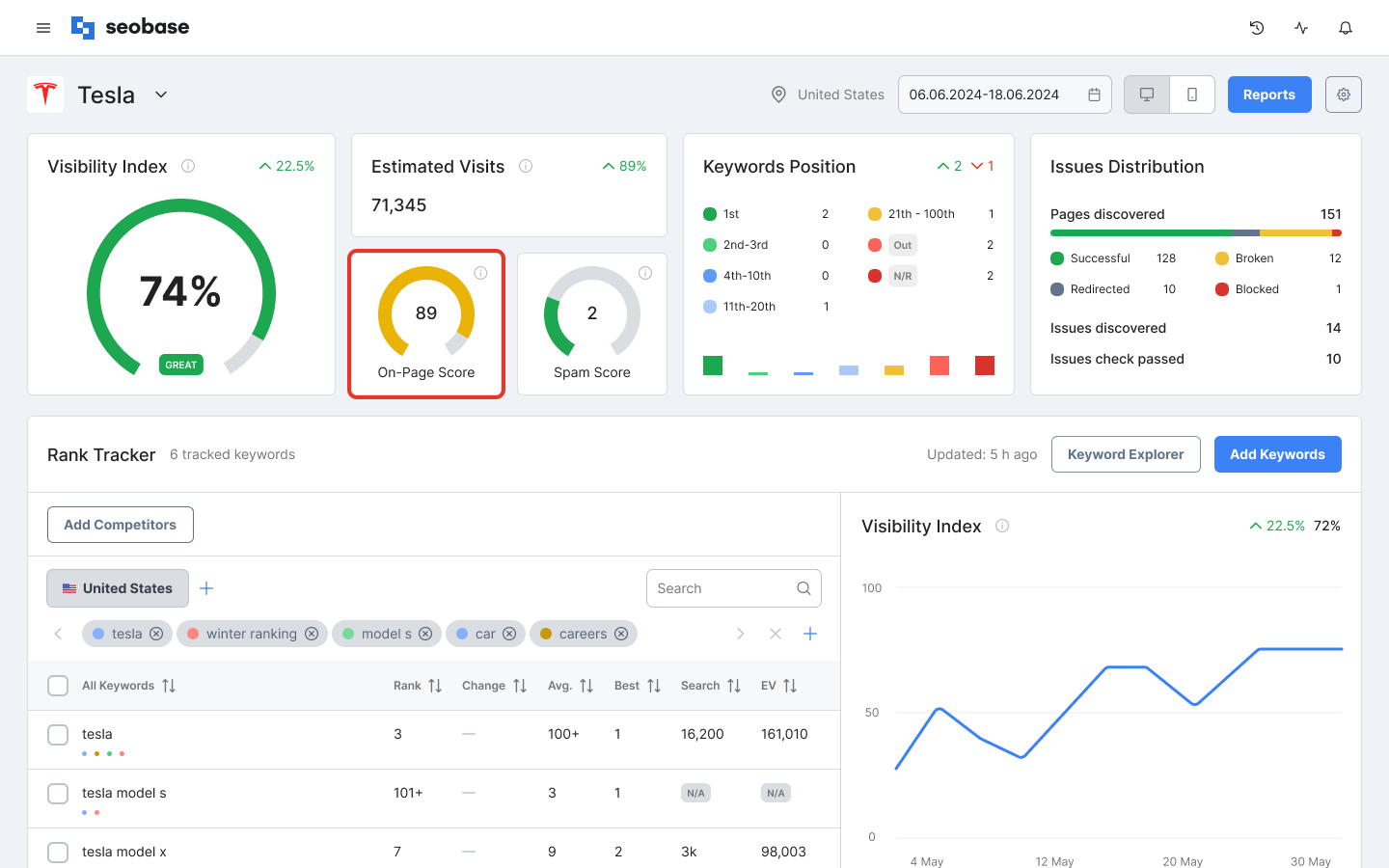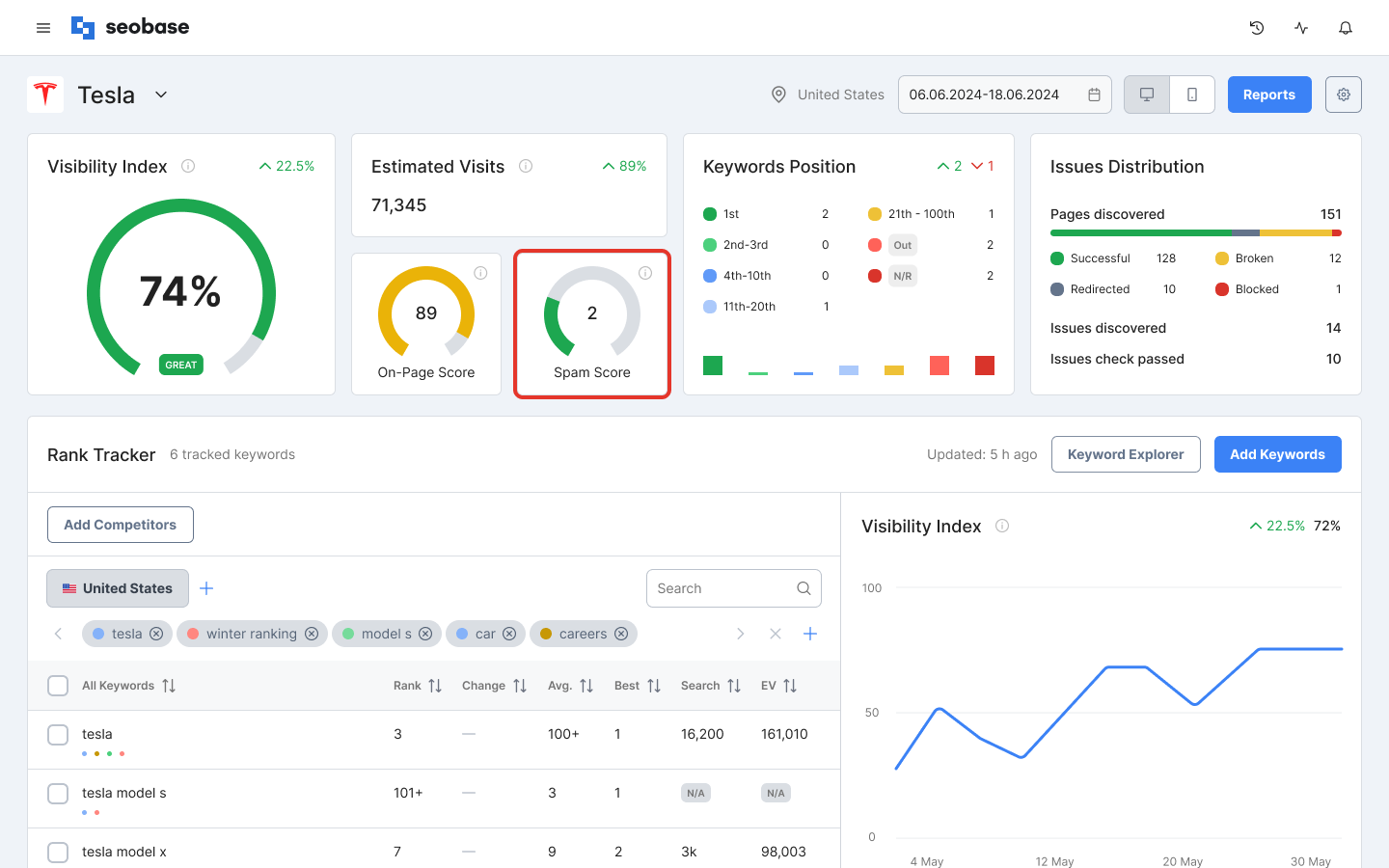What's Inside Your Dashboard?
In this article, we will explore the valuable features available to users when creating a project in seobase. A key highlight is the Dashboard, which gives users an overview of their project's metrics. These metrics and visually informative graphs are pulled from various tools within the seobase. This integrated approach offers users a comprehensive understanding of their project's performance, enabling them to make informed decisions and drive success.
Tracking Selector
To navigate through all projects within the system efficiently, utilize the tracking selector. Simply click on the downward arrow to expand the dropdown menu, and proceed to choose or search for the desired tracking option.
Date Range Settings
In the calendar, you have the option to choose your own specific date range for comparison. Alternatively, you can select from a range of predefined options such as Today, Last 7 days, Last 30 days, Last 90 days, or even the Entire history of a website tracking.
Once you've selected your desired date range, you will notice that the metrics for your keywords and the tracked website will dynamically update accordingly. This allows you to quickly analyze and understand how the performance of your keywords has evolved over time.
By leveraging this feature, you can gain valuable insights into the effectiveness of your SEO strategies and make informed decisions to optimize your website's performance.
Note: the latest date you can select was when your website tracking was created.
Switch to View Desktop vs. Mobile Platforms
seobase offers a convenient switcher that lets you easily view trackings for desktop and mobile platforms. This switcher is located within the platform and lets you quickly switch between the two views to access the relevant data. Once you create your project, the desktop and mobile tracking will be tracked automatically.
Automated Email Reports
seobase offers automatic email reports to keep your tracked websites in sight. Schedule regular updates for comprehensive insights on keyword rankings, organic traffic, and more.
Note: the first report will be sent shortly after the creation.
When setting up reports in seobase, it's crucial to understand how the sending schedule works based on the day of creation and the report type.
For daily reports, once you create the report, it will be sent to you and your recipients every day, starting from the day it was initially created.
Weekly reports follow a similar pattern. If you create a weekly report on a specific day, say Tuesday, it will be sent to you and your recipients every subsequent Tuesday.
Monthly reports operate differently. When you create a monthly report, the first report will be sent immediately after its creation. For example, if you create the report on 5 October, the first report will be sent shortly after. The subsequent reports will be sent on the same day of the month as the initial creation date (e.g., 5 November, December 5th).
In scenarios where the month following the report's creation has fewer days, the following report will be sent on the last day of that month. For instance, if you created the report on the 31st of a month and the next month has only 30 days, the following report will be sent on the 30th.
It's important to note that the sending schedule will be affected if you update a report and change its type. However, the sending date will remain unaffected if you change the report's name or recipients without altering its type.
Visibility Index
The Visibility Index in seobase simplifies the understanding of your keyword visibility on the search engine results page (SERP) by consolidating all keyword ranks into a single number. This index takes into account the fact that higher positions in search results are more visible to users compared to lower positions.
The Visibility Index is based on a scale where a keyword ranked at number one receives a score of 100. As the rank decreases, the Visibility Index also decreases accordingly. This means that the lower the rank of your keyword, the lower the Visibility Index will be.
By aggregating and calculating a moving average of all your keyword ranks, the Visibility Index provides a comprehensive and insightful measure of your overall keyword performance. This index offers a convenient and efficient way to track and evaluate the visibility of your keywords on the SERP.
Utilizing the Visibility Index in seobase allows you to monitor the performance of your keywords over time and make informed decisions to improve your search engine visibility.
Remember that adding a new keyword to your tracking will lower your Visibility Index at first (since we don't know how good that keyword is yet, it will "dilute" the overall Visibility Index at this point). But in the end, if the new keyword is good (meaning it is visible and has a high rank), your VI will go up eventually.
Understanding that the Visibility Index (VI) in seobase follows an exponential decrease as your rank position on the search engine results page (SERP) lowers. This means that even a small drop in rank can significantly decrease the Visibility Index.
For instance, if your website ranks #1 on the SERP, your Visibility Index will be 100. However, if your rank drops to #2, your Visibility Index decreases to 50. This illustrates how a relatively minor decline in rank (from position #1 to #2) can result in a substantial drop in the Visibility Index (from 100 to 50).
On the other hand, when your website ranks lower on the SERP, the impact on the Visibility Index becomes less pronounced. For example, if your website ranks #50, the Visibility Index is 5. If your rank drops to #80, the Visibility Index diminishes to 2. Here, you can observe that a more significant drop in rank (from #50 to #80) leads to a smaller gap in the Visibility Index (from 5 to 2).
This behavior occurs because ranking higher on the first SERP significantly boosts the Visibility Index. Being on the first page of search results increases the likelihood of user visibility, as users are more inclined to notice websites on the initial pages rather than deeper pages. Consequently, losing top positions on the SERP can substantially impact your overall visibility and the corresponding Visibility Index.
Understanding the relationship between rank position and the Visibility Index helps you comprehend the importance of maintaining higher rankings on the SERP. It emphasizes the significance of optimizing your SEO strategies to secure top positions and maximize your website's visibility to potential users.
Estimated Visits
The estimated Visits metric in seobase provides valuable insights into the potential traffic your tracked website can receive from keywords each month. It estimates the overall visitor count that can be generated based on your keyword rankings.
This metric considers the click-through rate (CTR) associated with each keyword's current search engine results page (SERP) position.
On-Page Score
The on-page score metrics displayed on the seobase project dashboard indicate how well your website performs concerning the various factors analyzed and optimized within the website, ultimately enhancing its visibility and ranking on search engines. These metrics primarily focus on the on-page elements and content of a website. Here are some standard on-page metrics in SEO:
Page Titles: The title tag is an HTML element that defines the title of a web page. It is a crucial on-page element that search engines consider when ranking a page.
Meta Descriptions: The meta description is an HTML attribute that concisely summarizes a web page's content. It appears in search engine results pages (SERPs) and can impact click-through rates.
Heading Tags: Heading tags (H1, H2, H3, etc.) are HTML elements that define the headings and subheadings on a web page. Proper use of heading tags helps search engines understand the structure and hierarchy of the content.
URL Structure: Optimized URLs should be descriptive, concise, and include relevant keywords. A clear URL structure helps search engines and users understand the page's content.
Keyword Usage: Strategically placing relevant keywords within the content, including headings, paragraphs, and image alt tags, can improve search engine rankings. However, keyword stuffing should be avoided.
Content Quality: High-quality, relevant, and engaging content is essential for SEO. It should provide value to users and address their search intent.
Internal Linking: Internal links connect different pages within a website. Proper internal linking helps search engines discover and navigate the site, improving its visibility.
Image Optimization: Images should be optimized adequately with descriptive file names and alt tags, helping search engines understand the content of the images.
Page Loading Speed: The time it takes for a web page to load is essential for both search engines and users. Faster loading speeds improve user experience and can positively impact rankings.
Mobile-Friendliness: With the increasing use of mobile devices, search engines consider mobile-friendliness a ranking factor. Websites should be responsive and provide a seamless user experience across different devices.
Monitoring and optimizing these on-page metrics can contribute to improved search engine rankings, organic traffic, and overall website performance.
Spam Score
The spam score metric on a seobase project dashboard indicates your website's potential spamminess. It measures how likely a website is to engage in spammy or manipulative practices that violate search engine guidelines.
SEO tools use varying criteria and algorithms to determine the factors and signals contributing to a website's spam score. However, some common indicators of spammy behavior. However, some common indicators of spammy behavior include
Low-quality or scraped content: Websites that feature thin or duplicate content or content copied from other sources may be flagged as potentially spammy.
Unnatural backlink profiles: Excessive or low-quality backlinks from irrelevant or suspicious websites can indicate manipulative link-building practices, often associated with spam.
Keyword stuffing: Overusing keywords unnaturally within the content or meta tags may trigger spam alerts.
Cloaking and hidden text: Techniques that hide text or present different content to search engines than what is shown to users are considered deceptive and spammy.
Malware or phishing: Websites infected with malware or engaging in phishing activities are spammy and pose a risk to users.
Note: The spam score is not an absolute measure of a website's spamminess. It's a heuristic metric that serves as a warning sign or red flag, indicating the need for further investigation. A high spam score doesn't necessarily mean that a website is engaging in spammy practices, but it suggests the need for a closer look at the site's SEO strategies and techniques.
Pro Tip: Website owners and SEO professionals can use the spam score metric to identify potential issues, review their website's SEO practices, and take appropriate actions to improve the site's quality, adhere to search engine guidelines, and maintain a good reputation in the eyes of search engines.
Keywords Position
Keyword Position Changes provide valuable insights into the performance of your keywords. You can comprehensively overview their performance by analyzing whether your keywords move up, down, or remain unchanged. This representation offers a great way to assess the effectiveness of your keyword strategies and make informed decisions to optimize your website's visibility and ranking.
Issues Distribution
Issues Distribution on the seobase project dashboard is the metrics that analyze and present the distribution of various issues identified on your website. These issues can include technical, on-page, or off-page SEO problems affecting your website's performance and rankings.
The Issues Distribution Metrics aims to provide a clear and organized overview of your website's issues. This allows you to prioritize and address them effectively to improve your website's overall SEO health.
Typically, these metrics categorize and display the distribution of issues based on their severity or impact level. For example, the Critical,High, Medium, and Low categories may indicate the detected issues' severity. This helps you understand the urgency and prioritize resolving the vital problems that may significantly impact your website's visibility and rankings.
By monitoring and tracking the Issues Distribution Metrics regularly, you can stay on top of potential SEO problems and take proactive steps to address them. This data-driven approach enables you to optimize your website, enhance user experience, and improve its search engine performance.
In conclusion, Rank Tracker offers comprehensive metrics that empower you to monitor, analyze, and optimize your keyword rankings. It provides valuable data on keyword positions, changes, search volume, difficulty, and SERP features. For more detailed information on how to use Rank Tracker and interpret its metrics, please take a look at the following article [How to Track and Monitor Your Metrics with Rank Tracker].

